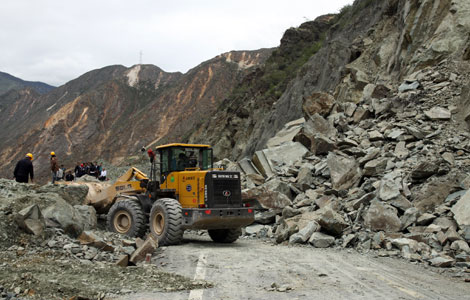Keeping open the lifeline to Tibet
Updated: 2013-10-28 07:38
By Hu Yongqi and Li Yingqing in Deqen, Yunnan (China Daily)
|
||||||||
Rocks and blizzards
Chen Qun said maintaining the section above the snowline, running from Shangri-La, the capital of Diqing, to Deqen, is the most difficult part of the job for the road teams.
The maintenance work has kept the highway open, despite the extreme weather conditions on the plateau, for more than 50 years, said Chen. The White Horse Snow Mountain nature reserve, which includes six townships around Deqen and in Weixi Lisu autonomous county, has the longest section of road - around 100 km - at an elevation of more than 3,500 meters, according to Chen.
The 70 workers at the Deqen Highway Maintenance Station are responsible for the upkeep of 340 km of the highway, including an old road from Shangri-La to Deqen.
The existing highway, which winds up to an altitude of 4,292 meters before plunging back down to the foot of the mountain, is often covered by a layer of snow, 130 centimeters deep at its worst, for half of the year.
From late October to early April, the highway snakes like a black ribbon across the white, snow-covered mountain and is particularly perilous during Chinese New Year, usually the coldest part of the year in these parts.
During his 16 years with the road team, Qi Er, head of the maintenance station, rarely stayed with his family during Chinese New Year, which is also known as Spring Festival.
Instead, he spent the most important festival for Chinese people on the "invisible road", directing men and machines as they worked to help stranded motorists. A few days before the 2008 Chinese New Year, more than 600 vehicles were stranded on the mountain and so Qi Er rushed to their aid.
"It was the coldest winter I have ever known. All the trees were crushed by the snow and ice. At night, blizzards made it difficult to identify the road and one false step might have sent us tumbling into the valley," he recalled.
Conditions were so bad that the maintenance workers could barely stand the icy winds and jagged flakes of snow that cut their faces like sharp knives. After just a few minutes of work, the men were unable to feel their cheeks.
"I had five or six veteran drivers for the giant snow plows, because they had a clear mental image of the road. Without that knowledge, they would have gone over the edges of the cliffs as they negotiated the wider turns," said Qi Er.
In one stranded truck, the workers discovered a driver with acute hypothermia, so they covered his frozen limbs with a thick coat. "If you hadn't come and rescued us, we might have died during the night," said the driver's father, who was also in the truck, in a mixture of Tibetan and Chinese.
The wide temperature fluctuations between day and night meant that melted snow flowed onto the reclaimed road during daylight hours, only to freeze again at night. Sometimes the layer was as thick as 40 cm. On one 100-km stretch of road, a lack of industrial salt and melting agents meant the workers were forced to break the ice with pickaxes, according to Zou Yanpeng, 23, a member of the road crew. "Each strike left a white crack in the ice, but the flying particles hit our cheeks with the force of bullets," he said.

 Serena completes dominant season with triumph
Serena completes dominant season with triumph
 Nuclear submarine fleet comes of age
Nuclear submarine fleet comes of age
 5 pharmacies begin to sell baby formula
5 pharmacies begin to sell baby formula Mother and four children stabbed to death in New York
Mother and four children stabbed to death in New York
 China Fashion Week S/S 2014: day 2
China Fashion Week S/S 2014: day 2
 Demonstrators protest against govt surveillance in US
Demonstrators protest against govt surveillance in US
 Where art thou, my love?
Where art thou, my love?
 Li Na reaches WTA Championships final
Li Na reaches WTA Championships final
Most Viewed
Editor's Picks

|

|

|

|

|

|
Today's Top News
High speed versus history
Southern states gear up for symposium
Film finds a hip-hop-tai chi connection
Jewelry exhibit dazzles Southern California
Obama aware of spying on Merkel: German paper
Five stabbed to death in NYC
Forum urges stable China-Japan ties
NSA spying hurts US diplomacy
US Weekly

|

|






